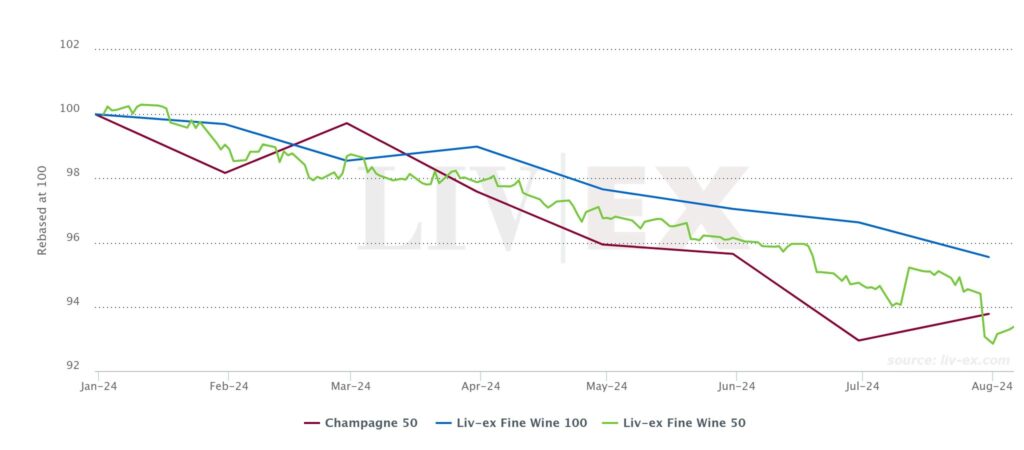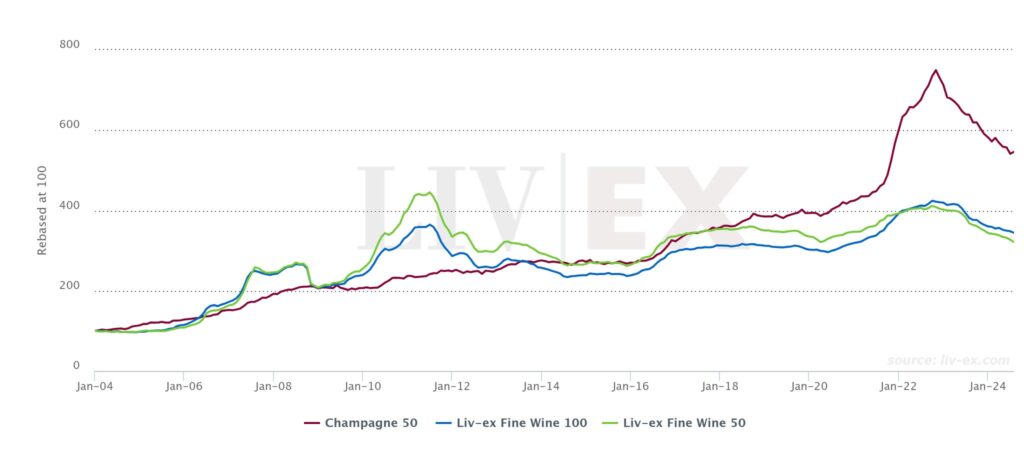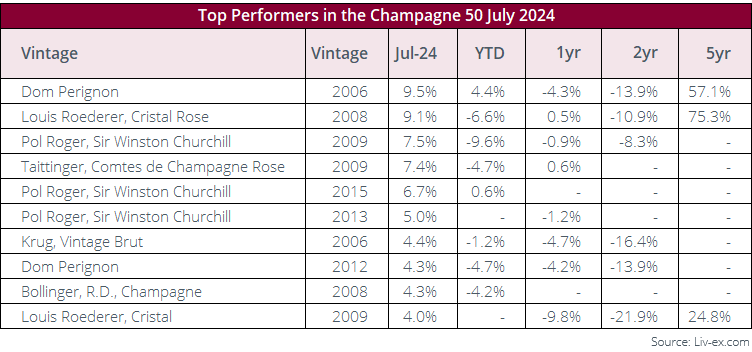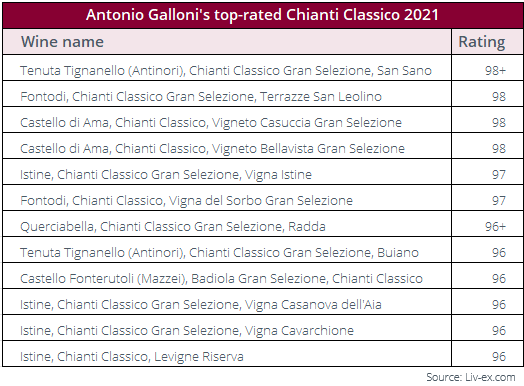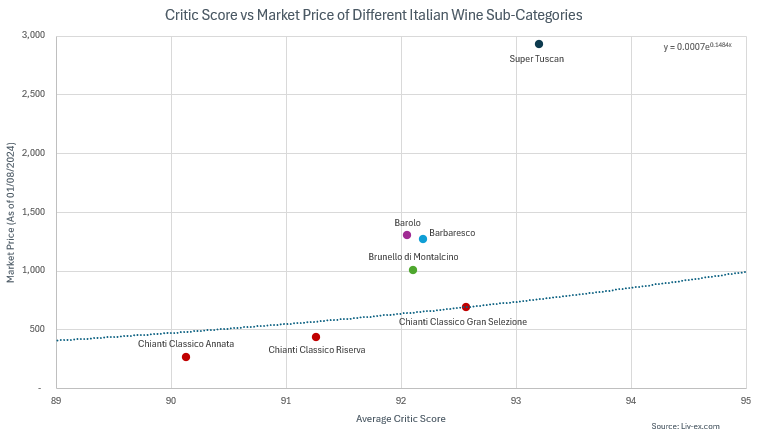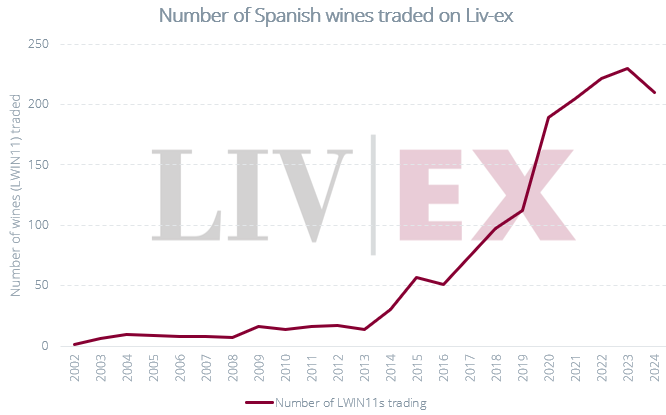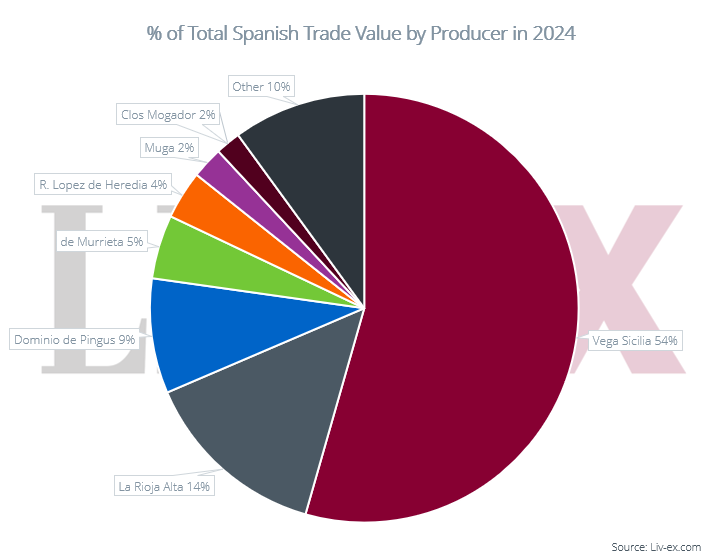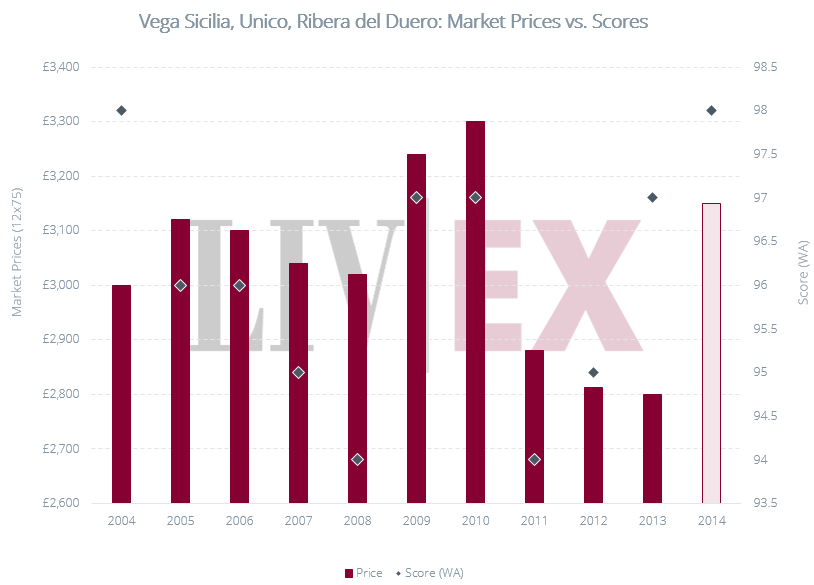August Market Report
- July saw the fine wine market’s downturn continue, the Liv-ex Fine Wine 100, the industry leading benchmark, falling 1.1%. Still, some indices have risen, as we explain in our look at the Champagne 50.
- In light of the up-coming La Place campaign, we explore the paradox of declining faith in Bordeaux’s En Primeur system, and producers from outside the region choosing to join.
- Chianti Classico might currently be one of the best examples of a misalignment between quality and price. We analyse how Chianti Classico is valued vis-à-vis its Italian competitors.
- Château Lafite Rothschild 2019 came in as the top-traded wine by value during H1 2024. Using technical analysis, we explore the possible future of price movements.
- 2024 has so far seen Spain’s performance on the secondary market gather momentum. We explore how trading of the region’s wines has changed over time.
Introduction – the downward trend continues
July saw the fine wine market’s downturn continue. The Liv-ex Fine Wine 100, the industry leading benchmark, fell 1.1% in July, a sharper fall than recorded in June (-0.4%) and May (-0.6%).
The wider market, represented by the Liv-ex Fine Wine 1000 (which tracks 1,000 wines from across the world), fell by 0.7%, a lesser fall than the -1.2% registered in June. As the market continues to search for safe havens, the Bordeaux Legends 40, which tracks the performance of 40 Bordeaux wines from exceptional older vintages (from 1989 onwards), registered a small rise for the second consecutive month (0.2%). The Champagne 50 also recorded a rise (0.9%), recovering some of its recent losses.
July also saw a fall in the number of unique brands (LWIN7s) traded (-2.8%), with the number of unique wines (LWIN11s) changing hands also falling 3.1%.
Index insight – the Champagne 50
July saw the Champagne 50 reverse its recent downward trend, the index recording a 0.9% increase month-on-month. Over the longer-term, despite a sharp fall since its peak in October 2022 (down 27.1%), the Champagne 50 still sits 41.4% above where it was before the Covid-inspired bull run. Whether or not July’s rise was just a momentary respite or a signal of the turning of the tide, it’s worth taking a slightly deeper look at what drove the July uptick.
While 2024 has seen numerous Champagne releases falling flat, July saw older vintages from the Grandes Marques recording rises. One might draw a similarity with what we’ve seen recently in Bordeaux with the Legends 40 showing signs of bottoming out while the Liv-ex 50 (which comprises more recent vintages) continues to fall. As buyers struggle to find value in new releases, they are drawn towards opportunities with back vintages.
Dom Pérignon 2006 topped the chart, rising 9.5%. It last traded at £1,650, a 79.3% increase on its original release price of £920. While it trades significantly less frequently than the heralded 2008 vintage, this does represent an opportunity to market participants. With less trading activity, buyers and sellers alike have an increased chance of transacting at their chosen price rather than that set by the collective market.
Liv-ex trades of Dom Pérignon 2006

News Insight – La Place paradox
La Place’s position within the fine wine trade currently represents a singular paradox. On the one hand a lacklustre En Primeur campaign called into question the sustainability of the system, and on the other we continue to see producers from outside Bordeaux putting their faith into the system for their releases.
July saw a blockbuster interview with Philippe Tapié (CEO of négociant Haut Médoc Sélection as well as chairman of Bordeaux Négoce) in which he made a clear call for a system reset. Tapié highlighted two intertwined and fundamental aspects of a healthy En Primeur campaign. The first is its role in Bordeaux’s unique wine distribution practice which differentiates it from that of other regions. It represents a unique opportunity to ‘secure access to the origin of the product’.
The second defining aspect of the system is that ‘the professional and the individual buying En Primeur must have earned money 24 or 36 months later’. This was largely missing from the recent campaign, which leads Tapié to argue that next year’s En Primeur is critical – if ‘we do not re-establish its credibility, it will be over’. In other words, La Place’s advantages with distribution won’t sustain it if the economic incentive for buyers is not there.
Thus the paradox – while figures within Bordeaux call for drastic change, we see the likes of Ernst Loosen and Schloss Johannisberg announce plans to release new wines on to La Place during this September’s Beyond Bordeaux releases. Undoubtedly, the system’s unparalleled distribution network continues to represent a uniquely appealing opportunity for producers to reach wider audiences than they would through individual distributors. However, as Tapié himself noted: ‘Bordeaux is not a brand creator. Bordeaux is a brand optimiser’, also arguing that La Place continues to look outside of the region because ‘we have to make a living. We go to people who pay us’.
So what could September’s releases hold in store? It will remain a difficult sell for new wines being launched through La Place. With a market that continues to look tentatively for secure safe havens such as mature blue-chip Bordeaux, and with sentiment remaining low, it is a tough time to be trying to build a brand.
For established brands like Opus One and Masseto – two mainstays of the Beyond Bordeaux releases by now – as with Bordeaux En Primeur, the challenge will be to entice merchants to buy the new vintage over mature ones that are nearing their drinking windows. In other words, support the value premise that historically underpinned the economics of La Place for merchants and end consumers. Masseto 2021 represents an interesting case.
It will enter the market buoyed by a perfect 100-point score from Antonio Galloni, who has called it ‘quite simply the most exquisite, refined young Masseto I have ever tasted’. It remains to be seen whether its top score will support a high price. One expects that it will probably need to be pitched around the current market price of other recent (lower-rated) vintages. The 2020, released at 9.4% above the 2019, and seemingly fair value at the time with its high ratings, has traded consistently below market price over the past year.
Liv-ex trades of Masseto 2020

Critical corner – undervalued Chianti Classico
Chianti Classico might currently be one of the best examples of a misalignment between quality and price. As Antonio Galloni (Vinous) writes in his article Chianti Classico: The Magnificent 2021s, ‘Chianti Classico continues to offer some of the best values in wine…Chianti Classico Annata remains one of the most compelling values in Old World wines with a sense of place’.
Galloni’s ratings for the 2021 vintage underline Chianti Classico’s quality, with the region producing ‘majestic wines endowed with striking aromatics, layered fruit and all the energy that is such a signature of the appellation’.
Given the region’s ever-increasing quality, alongside the Gran Selezione category seemingly catching hold, and legal changes now permitting the inclusion of specific subzones on wine labels, it is an interesting time to be buying Chianti Classico. This is particularly the case since across all levels of Chianti Classico’s quality pyramid, the region’s wines deliver better quality price ratios than other leading Italian red wine categories.
While Chianti Classico Annata and Riserva offer great opportunities for terroir-driven wines at modest prices, Gran Selezione might be the most interesting category for collectors. Compared to other Italian regions, Chianti Classico Gran Selezione is, on average, rated more highly than 58% of wines, but is cheaper than 54%. Notably, they generally represent better value than their Tuscan counterparts in Brunello di Montalcino, as well as Piedmont’s Barolo and Barbaresco.
Another intriguing aspect of Chianti Classico is the lower price it often commands relative to declassified 100% Sangiovese wines, while competing in terms of quality. Fontodi’s wines are an example of this. Focusing on the market performance of the 2016 vintage of Colli della Toscana Centrale Flaccianello della Pieve and Chianti Classico Vigna del Sorbo Gran Selezione gives interesting insight.
Liv-ex trades of Flaccianello della Pieve 2016
Liv-ex trades of Vigna del Sorbo Gran Selezione 2016

Both wines are very highly-rated, Flaccianello delle Pieve 2016 receiving an average 98 points and Vigna del Sorbo 2016 97. Yet, the Flaccianello della Pieve commands a significant premium, currently over 2.6x the price of the Vigna del Sorbo Gran Selezione (£1680 vs £640). Flaccianello della Pieve’s significantly higher trading volumes can be to some degree explained by higher production volumes (c.2.4x on average). Its price nevertheless confirms that the wine’s grip on the fine wine market is currently significantly stronger than that of Vigna del Sorbo Gran Selezione.
Chart of the month – technical analysis of Château Lafite Rothschild 2019
Château Lafite Rothschild 2019 came in as the top-traded wine by value during H1 2024. Despite the wine’s popularity, its prices have fallen considerably over the past two years. The wine was released En Primeur at £5,112 per 12×75. After being physically released in early 2022, it first traded on the exchange at £7,330 – a gain of 43.4%. Since then, however, prices have fallen steadily. It last traded at £4,844, 5.3% below its original release price. Today, we conduct a technical analysis of Lafite 2019’s price movements, to assess possible future directions.
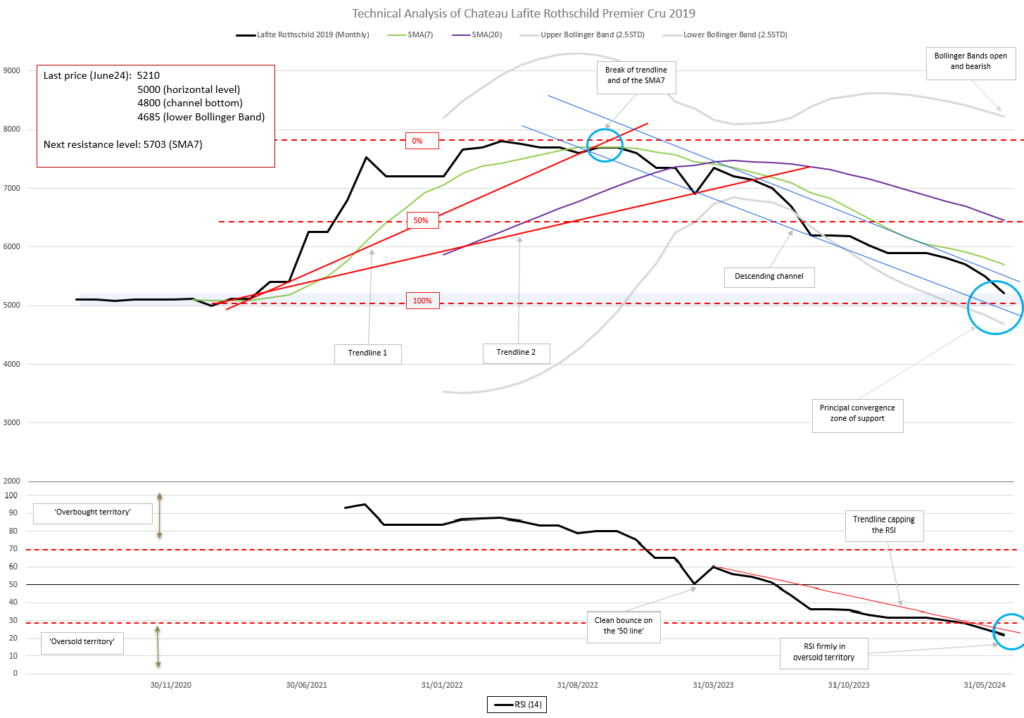
In March 2023, in conjunction with a simultaneous bounce of the Relative Strength Index (RSI) on its ’50 line’, prices of Lafite 2019 tested ‘Trendline 2’, temporarily rising. This gave time for the SMA7 to drop below the SMA20 – a phenomenon often referred to as a ‘deathcross’. A likely indicator that prices are going to fall, this cross confirmed the bearish trend. We note that, since the break, the RSI has continued to fall deep into oversold territory (below 30) and is showing no sign of reversing.
Over the last two years, the price of Lafite Rothschild 2019 has evolved within a descending channel, indicated by the blue trendlines. Proponents of Fibonacci mathematics will observe that the prices have now retraced almost 100% of the move up from En Primeur release pricing. The convergence of this horizontal Fibonacci retracement and the lower bound of the channel may provide some support.
If prices bounce off this convergence zone, we may finally see a trend reversal. If this is the case, we will watch for a reaction against the upper bound of the channel. As shown in the chart, prices rose temporarily in early-mid 2023 and early 2024, but in both cases bounced off the upper bound of the channel, keeping the bearish trend in tact. Should the price break through the upper bound, the next resistance level is the SMA7, currently at £5,703.
That being said, the Bollinger Bands remain wide open and falling – a bearish continuation sign. While no technical indicator currently points toward an imminent trend reversal, there is some evidence that prices should at least stagnate around the original release price – the point at which sellers no longer turn profit with wine they had bought En Primeur. As shown below, this has been the case for the 2016 vintage of Lafite Rothschild. Prices dropped to release price levels in late 2019 and did so again earlier this year, but in both cases bounced. Should this be the case for the 2019 vintage, the floor may already be in sight.
Liv-ex trades of Château Lafite Rothschild 2016 on Liv-ex

Final thought – Spain on the move
Although not as sought-after as its French or Italian counterparts, the demand for Spanish wine has enjoyed a sustained increase in demand over recent years. 2024 has so far seen Spain’s performance on the secondary market gather momentum. Year to date, Spain’s share of trade value has more than doubled compared to the same period in 2023 (2.2% vs 0.9%). At the same time, in volume terms Spain has traded 20.5% more than the US (albeit at 35.5% of value).
Looking at where this surge in demand for Spanish wine is coming from, in 2023 US buying accounted for 43.4% of the total, Europe 30.5%, the UK 21.3%, and Asia 4.9%. In 2024 the US has accounted for 57.0% against Europe at 18.8%, Asia at 12.8% and the UK at 11.4%. It would seem therefore that the US is driving most of the increased interest.
Ribera del Duero has long been the focus region for Spanish fine wine investors. In 2014, the region accounted for 85.0% of all Spanish wine traded on Liv-ex by value. So far this year, it has taken 64.6% of Spanish market share by value. Rioja has taken the second largest share (28.8% in 2024 year-to-date) with increased demand for brands such as La Rioja Alta and Marques de Murrieta. Again, this demand seems to be driven by the US. Ten years ago, UK buyers accounted for 47.7% of total Rioja traded, whereas so far in 2024, the US has accounted for 48.4%.
Despite some success from other regions and brands, it is clear from the chart above that Ribera del Duero’s Vega Sicilia continues to be the darling of Spanish fine wine.
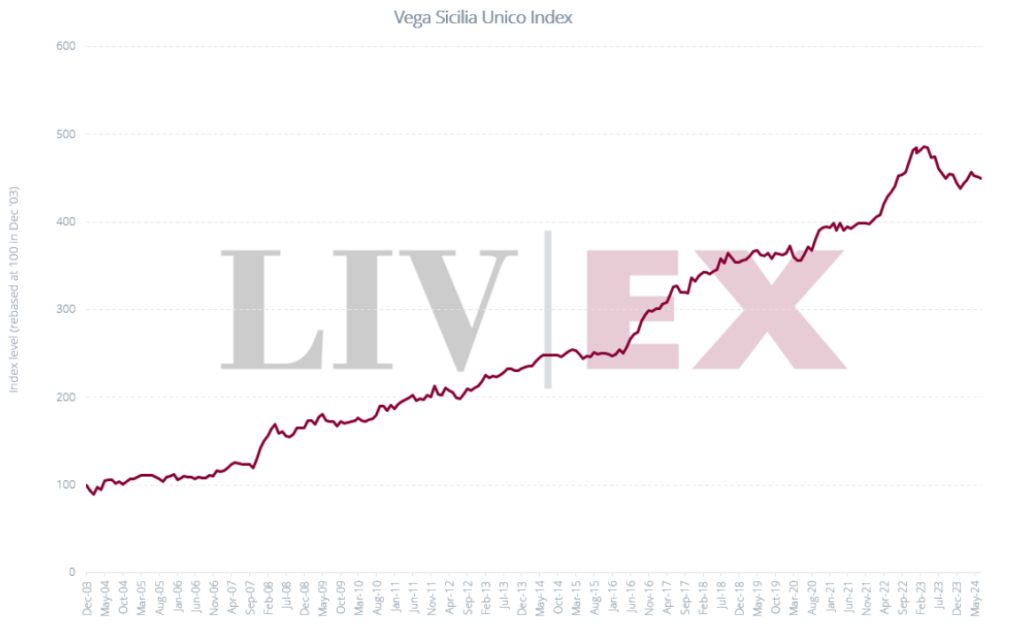
Único 2004 first hit the UK market at £1,920 per 12×75. Originally awarded 97 points by the Wine Advocate, the wine was rescored up to 98 points in 2023 by the same publication. The wine last changed hands for £2,888 per 12×75, making it one of the best value vintages currently available.
The 2013 currently looks like an attractive option. Just entering its drinking window, and scoring 97 points with the Wine Advocate, it is available at a significant discount to the similarly rated 2009 and 2010.

